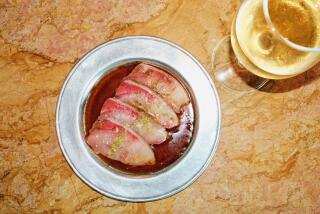Where the Locals Eat Fire and Ash
It was one of those nights when the guidebook-recommnded restaurants turned out to be soulless tourist traps. Out of desperation, I asked my cab driver his favorite eating place.
“I think maybe you won’t like it,” he warned, as we rode through the streets of Juarez, Mexico. “It’s very simple, and there aren’t any foreigners.”
But the first whiff of the dining room--a commingling of seared beef and mesquite smoke--told me I had hit pay dirt.
The cabby was right: Mitla isn’t fancy. In fact, the tiny restaurant (perhaps 40 seats) has occupied the same low-ceilinged space for 25 years. Time and smoke have darkened the once-white walls to a color between tan and gray. Guests sit on straight-back wooden chairs at Formica tables crowned with salt shakers made from baby food jars. A mournful mounted stag head surveys the scene, while a noisy TV provides white-noise background ambience.
Mitla, I am told, is the Aztec word for “hell.” The inferno for which the restaurant is named is a horseshoe-shaped, green-and-white-tiled barbecue pit built into the back wall of the dining room. Mitla’s Mexico City-born owner, Fernando Duran, fuels the pit with mesquite from the Chihuahua highlands. The gnarled, twisted mesquite logs are about as thick as an arm. Duran burns more than 800 pounds of wood a week.
The grill itself is a cast-iron grate that slopes upward as it goes back. This ingenious system, found throughout Latin America but seldom in the United States, enables the chef to control the cooking temperature by moving the steaks forward and backward, nearer and farther from the flames.
Surprisingly, Mitla’s beef comes not from Sonora or Chihuahua (Mexico’s beef-producing regions), but from the nearby United States. (“It’s cheaper,” Duran explained.)
The steaks are neatly arranged for customers to inspect in a refrigerated deli case. There are four cuts to choose from: little sirloin, big sirloin, T-bone and chuleta diesmillo. The latter is a thin rib steak with the bone attached--a cut that owes its rectilinear neatness to being cut on a band saw.
As an American reared on Bible-thick steaks, I was surprised by the modest dimensions of Mitla’s steaks. The pieces are broad and wide (perhaps 6x12 inches), but only 1/2-inch thick. (Because the steaks are so thin, the chef salts only one side during grilling.) There seem to be two advantages to cutting the steak this thin: The meat cooks quickly, so it’s easy to gauge accurate doneness, and the broad, thin cut maximizes the surface area of the steak, allowing for maximum absorption of the mesquite smoke flavor.
And soak up the flavor it does. Mitla’s sirloins are about the smokiest, juiciest steaks ever to have crossed my molars. They melt on the tongue with a strong whiff of smoke and a succulent slurp of meat juice.
As befits a good steak house, Mitla’s menu is limited--and so are the accompaniments. Steaks are served with a little lettuce and tomato, some fire-warmed tortillas and a smoky salsa made from tomatoes and fiery chiles de arbol. Like the steak, the salsa acquires its distinctive smoke flavor from the grilling of the tomatoes over mesquite.
But simple doesn’t mean simple-minded. The proper way to eat a Mitla steak is to cut it into pieces, drizzle it with salsa and wrap it in fire-charred tortillas. The resulting flavors are earthy and elemental: chiles, wheat and beef.
Mitla is located at Hermanos Escobar 2325 in Juarez. If you’re staying in El Paso, it’s just a short cab ride over the Rio Grande. It’s cheaper and easier to negotiate the price of a round trip and have the cabbie wait for you. Better yet, invite him to dine with you. You never know what other great restaurants he may have up his sleeve.
MESQUITE-GRILLED STEAK WITH FIRE-CHARRED TOMATO SALSA
The best way to cook the beef would be over a mesquite log fire. Barring that, toss on a charcoal fire or in the smoker box of your gas grill about 2 cups of mesquite wood chips that have been soaked in cold water for an hour. If using mesquite logs or charcoal grill, build a hot fire and let it burn down to glowing coals. If using a gas grill, preheat to high.
SALSA
2 to 4 chiles de arbol, depending on taste
2 large tomatoes
1/3 onion, sliced
1 clove garlic, sliced
3 tablespoons coarsely chopped cilantro
1 to 2 tablespoons lime juice
Salt
Freshly ground black pepper
STEAKS
Salt
4 (10-ounce) sirloin or T-bone steaks, each about 1/2 inch thick
4 large or 8 small flour tortillas
SALSA
Soak chiles in bowl of warm water until pliable, about 20 minutes.
Grill tomatoes over high heat until skins are charred and blistered on all sides, 6 to 8 minutes. Transfer to plate and cool.
Drain chiles and puree to coarse paste in blender with tomatoes, onion, garlic and cilantro. Add lime juice and salt and pepper to taste. (Note: This may make more salsa than you’ll need for 4 steaks; any excess goes great with chips and stores well in refrigerator.)
Transfer salsa to serving bowl.
STEAKS
Generously salt each steak on 1 side. Grill over high heat, salt side down first, until cooked to taste, 2 to 3 minutes per side for medium rare.
Grill tortillas until soft, pliable and lightly browned, about 20 seconds per side.
Serve steaks on platter or plates, with tortillas and salsa on side.
4 servings. Each serving:
566 calories; 1,310 mg sodium; 108 mg cholesterol; 36 grams fat; 29 grams carbohydrates; 30 grams protein; 2.70 grams fiber.
More to Read
Sign up for The Wild
We’ll help you find the best places to hike, bike and run, as well as the perfect silent spots for meditation and yoga.
You may occasionally receive promotional content from the Los Angeles Times.






